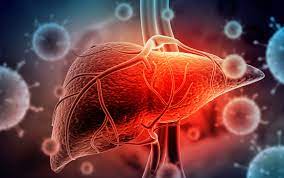
Hepatitis B
Hepatitis B is a serious and common infectious disease of the liver, caused by the hepatitis B virus (HBV), an enveloped virus containing a partially double stranded, circular DNA genome, and classified within the family hepadnavirus. HBV has the incubation period of about 3-26 weeks.
In addition, HBV carriers can transmit the disease for many years. Infection occurs very often in early childhood when it is asymptomatic and often leads to the chronic carrier state.
It is of two types, acute (short duration, <6 months, asymptomatic, acute viral hepatitis, acute liver failure) and chronic (long duration, >6 months, chronic viral infection, compensated cirrhosis, decompensated cirrhosis).
Mode of Transmission
- Oral route
- Percutaneous/parenteral contact with infected blood or body fluids
- Sexual intercourse
- Sharing needles, syringes, or other drug-injection equipment
- Surgical instruments
- Contact with infected surfaces, e.g., table-tops, razor blades, blood stains (HBV has the capacity of remaining on surfaces for about a week without losing its infectivity)
- Amniocentesis
- Vertical transmission (from infected mother to baby at birth)
- People who are carriers of HBV surface antigen, HBsAg
Pathophysiological Stages
This process comprises of the following stages:
- Replication of hepatocytes by following a number of steps given below;
- Binding of HBV to a receptor (i.e., transferrin receptor, asialoglycoprotien receptor molecule, or human liver endonexin) on the surface of hepatocyte
- Entrance of viral nucleocapsids into the cell and reaching the nucleus to deliver the viral genome
- Completion of synthesis of second-strand DNA and repairing of the gaps in both strands to yield a covalently closed circular (ccc) supercoiled DNA molecule that serves as a template for transcription of four viral RNAs that are 3.5, 2.4, 2.1, and 0.7 kb long
- Transportation of these transcripts to the cytoplasm where their translation into the viral nucleocapsid and precore antigen (C, pre-C), polymerase (P), envelope [L (large), M (medium), S (small)], & transcriptional transactivating proteins (X) takes place
- Insertion of envelope proteins themselves as integral membrane proteins into the lipid membrane of the endoplasmic reticulum (ER)
- Formation of new mature viral nucleocapsid which then enters into the following intracellular pathways;
- Formation and secretion of new virions
- Amplification of the viral genome inside the cell nucleus
- Activation of immune system to produce a specific reaction to combat and possibly eradicate the infectious agent
- Inflammation of liver as a consequence of pathological damage
Signs and Symptoms
Many people with Hepatitis B do not have symptoms and do not know they are infected. Even though a person has no symptoms, the virus can still be detected in the blood. Symptoms of Hepatitis B can take up to 30 years to develop. Damage to the liver can silently occur during this time. When symptoms do appear, they often are a sign of advanced liver disease and can include;
- Fever
- Fatigue & weakness
- Abdominal pain
- Dark urine
- Loss of appetite
- Nausea & vomiting
- Joint pain
- Jaundice (yellowing of skin and whites of eyes)
- Achy muscles
- Loose stools/diarrhoea
Causes & Risk Factors
- HBV (Hepatitis B Virus)
- Sexual contact
- Use of unsterile instruments
- Travelling to a country where HBV is prevalent
- Infected pregnant women
- Homosexuality & HIV infected persons
- Hemodialysis
- People receiving chemotherapy or other types of immunosuppressive therapies
Diagnostic Test
- HBV panel blood tests such as;
- HBsAg test
- Anti-HBs of HBsAb
- Anti-HBc or HBcAb
- Anti-HBc IgM or anti-HBc IgG
- HBeAg
- Anti-HBeAb or HBeAb
- HBV DNA quantification test
- Liver enzymes test (ALT, AST, AFP, Ferritin, GGT, Alkaline phosphatase)
- Ultrasound & transient elastography
- CT scan
- Hepatic biopsy
Complications
- Development of chronic hepatic insufficiency
- Cirrhosis
- Hepatocellular carcinoma (HCC)
Medical Treatment
There are two main classes of treatment;
- Antivirals: aimed at suppressing or destroying HBV by interfering with viral replication
- Immune modulators: aimed at helping the human immune system to mount a defense against the virus.
Prevention
- Immunization with hepatitis B vaccine & vaccination campaigns
- Preventing HBV transmission during early childhood by integrating HB vaccine into childhood vaccination schedules
- Routine screening of blood donors for HBsAg
- Safety handling of human blood and body fluids
- Good personal hygiene, strict surveillance, and appropriate environmental control measures to limit transmission
Conclusion
In conclusion, Hepatitis B presents a significant health concern globally, with its potential complications, diverse symptoms, treatment modalities, and preventive strategies. Complications of Hepatitis B can range from chronic liver inflammation to cirrhosis and hepatocellular carcinoma, underscoring the importance of timely diagnosis and intervention.
Recognizing the signs and symptoms of Hepatitis B, such as fatigue, jaundice, and abdominal pain, is essential for early detection and management. While there is no cure for Hepatitis B, various treatment options, including antiviral medications and interferon therapy, can help suppress the virus and reduce the risk of complications.
Prevention plays a crucial role in controlling Hepatitis B transmission. Vaccination, particularly at birth and during childhood, is highly effective in preventing new infections. Additionally, practicing safe sex, avoiding needle sharing, and ensuring the safety of blood products are important preventive measures.
By promoting awareness, implementing vaccination programs, and adopting preventive practices, we can collectively combat Hepatitis B and mitigate its impact on individual health and public health systems worldwide.



